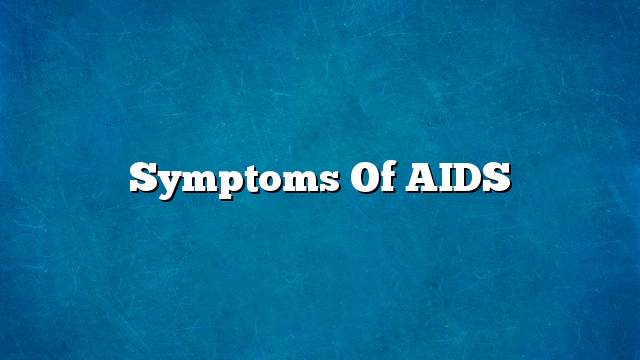HIV and AIDS
The function of human immunodeficiency virus is to weaken the human immune system and thus make the body less efficient in fighting germs, whether fungal or viral, and AIDS (Aquire Immunodeficiency Syndrome) Syndrome occurs when the body completely stops its ability to fight disease, it is the last stage of HIV infection.
AIDS symptoms and stages
HIV infection is divided into three phases that become more severe over time if treatment is not properly addressed. These stages are respectively as follows:
Acute phase
At this stage, the virus proliferates rapidly, spreads throughout the body, and destroys the cells of the immune system fighting inflammation, and this phase is accompanied by symptoms similar to the symptoms of influenza, including:
These symptoms often persist for one to two weeks, and stop when HIV defeats the immune system. This stage usually begins two to four weeks after exposure to the virus, during which the patient is more able to transmit the disease than the other stages.
It is reported that in the event of rapid intervention – within three days of exposure to the virus – doctors can prevent the disease from the establishment of the body; it is believed that he had been exposed to the virus because of sex with another person infected with the need to get drugs against him as soon as possible.
Chronic stage
Which lasts for 10 years or more, the stage where the symptoms disappear, in which the virus destroys the immune system, usually known as the stage of the stage or the absence of symptoms, because the symptoms can not be seen or feel during it, To others without feeling that he is already infected.
It is noteworthy that at this stage can be used a range of drugs that help rebuild the immune system and prevent the spread of the virus, which is being attacked with these drugs; the use of these drugs and adherence to healthy habits may prevent the worsening of the situation to the third phase, AIDS.
AIDS
This is the last stage of HIV infection, in which the body loses its ability to fight opportunistic infections completely because the virus has destroyed the immune system, and opportunistic infections are known as infections or cancers caused by infections of people who have weak immune systems More frequently than those with healthy immune systems.
Symptoms of this stage, which make a person aware of AIDS, include the following:
- Continuous feeling of fatigue.
- Uncertain weight loss.
- High temperatures for more than 10 days.
- Night sweats.
- Inflammation of the lymph nodes in the neck or thigh.
- Diarrhea is severe and long-term.
- Yeast infection in the mouth, throat or vagina.
- hard breathing.
- The appearance of violet stains color does not disappear from the skin.
- Uncontrolled bruising or bleeding.
HIV transmission from one stage to another
There are many factors that help to speed the transmission of HIV infections from one phase to another. The factors that affect this include:
- Genetic makeup.
- The time of diagnosis; ie whether it was early or late after infection.
- Commit to visiting the treating physician or not.
- Care and treatments received by the injured person.
- Obligation to use prescription drugs or not.
- Pre-injury health status.
- Commitment to living a healthy life or not, by exercising, eating healthy foods, and quitting smoking.
Factors affecting the transition process
Factors that shorten the time between transition from HIV to AIDS include:
- Subtype of HIV.
- The infection is associated with another infection, such as tuberculosis and hepatitis C, for example.
- Age.
- Genetic Background.
- Exposure to severe psychological stress.
- Malnutrition.
Factors that slow down HIV infection
The factors that slow the process of HIV transmission to AIDS include the following:
- • Continuous use of drugs for this disease.
- Careful compliance with doctor’s instructions.
- Continue to care for HIV infection.
- Genetic Background.
- Eat healthy foods.
How to transmit AIDS
AIDS is transmitted from person to person when involved in certain bodily fluids, including blood, but it is not transmitted through saliva, tears, sweat, or urine. Moving it clearly is not as easy as other infections. The methods through which HIV / AIDS transmits include:
- Having sex with an infected person.
- Mother-to-child transmission during childbirth or breastfeeding.
- Participate using needles contaminated with the blood of an infected person.
